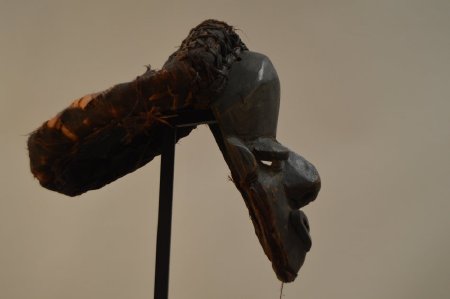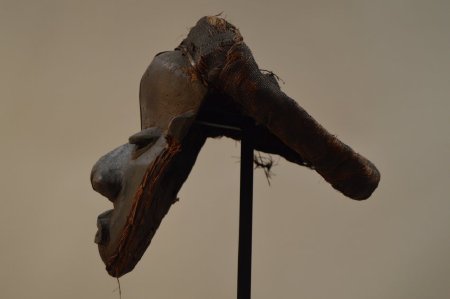Title:
Distortion Mask
Object Name:
Mask, Ritual
Other Name:
Mask, Dance, Distortion
Place of Origin:
Pende, Democratic Republic of Congo, Africa
Provenance:
Aboriginal Indigenous Art.
H = 10—1/2"
W = 8"
D = 11"
Distorted faces are rarely depicted in African art. For the Pende, they represent the effect of an epileptic seizure, which was thought to be a manifestation of the spirits. The use (in some masks), of black and white pigments emphasizes the overall distortion of the faces.
Western Pende people use around fifteen different types of mask during their ceremonies. They all have down—cast eyes, a triangular nose and a protruding mouth which sometimes bears teeth.
The Pende were pushed northwards by the Lunda people during the 17th century, so they settled in a region near the Loango and Kasai Rivers.
H = 10—1/2"
W = 8"
D = 11"
Distorted faces are rarely depicted in African art. For the Pende, they represent the effect of an epileptic seizure, which was thought to be a manifestation of the spirits. The use (in some masks), of black and white pigments emphasizes the overall distortion of the faces.
Western Pende people use around fifteen different types of mask during their ceremonies. They all have down—cast eyes, a triangular nose and a protruding mouth which sometimes bears teeth.
The Pende were pushed northwards by the Lunda people during the 17th century, so they settled in a region near the Loango and Kasai Rivers.
Description:
Dance mask with cloth covered headdress, protruding forehead with deepset slit eyes with slit centers and heavy upper lids, wedge—shaped nose twisted to right side, left extended nostril, slanted slit protruding mouth indicating stroke victim, black patina over entire surface with blue cheeks.
Collection:
Finley Collection
Material:
Wood W/Cloth and Raffia
Used:
Ritually Used
Technique:
Carving / Weaving
Owned:
Art Department, Missouri Southern State University
Accession#:
2014.1.1



